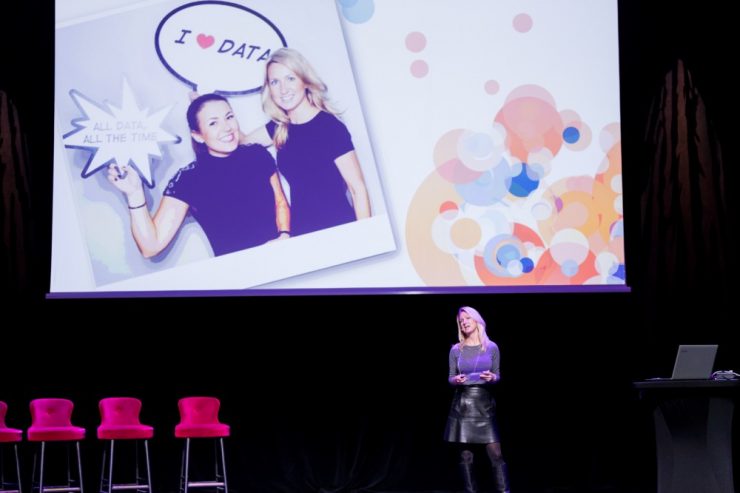In a previous post, we talked about one of our Nordic Women and Data Summit Chairwomen, Dacil Ullman and her experience with bridging the gap between IT and business. This week, we focus on our other Chairwoman – Linda Borelius, CEO at Sparks AB. We don’t see Linda first time in this role, she was a Nordic Women and Data Summit Chairwoman last year too. In her opening remarks, she discussed her beginnings and decisions to start a career in data. Having more than 20 years of hands-on experience in the industry, Linda gave a very comprehensive overview of what data and analytics looked like 2 decades ago, tools used, processes and challenges in the early days.


Data and Analytics: Then and now
What it was all about back then, was standardising around one data platform, emphasises Linda. The general belief was that it’s possible to build one mega data warehouse which holds the ultimate truth and answer all the questions. The tools that they were using were extremely complex so usually business needed IT to build their reports.
Data modelling was a hot topic and the main debate was around which model to use. “Did we think the world has some easy answers for us”, remembers Linda.
However, as the industry progressed and evolved, Linda knew that her decision to start a career in data was the best decision in her life.


The rise of the digital native companies and data-driven organisations
Skipping to the present day, it’s never been more important to make sense of data, Linda states. The digital universe is huge and it’s still growing.
And this new digital era brings about a new kind of competition. There are new superstars on the scene overshadowing traditional businesses – the so-called digital natives, the Millennials of the business world – companies that were born in the digital age. Traditional businesses became aware that they needed to adapt to this change and stay ahead with data and analytics so they can survive in this new digital order.
Today companies are aware of the power of data and the capacity to use data to ask the right questions – and this is how they can influence a change in a product, service, process or behaviour. These companies that have understood the importance of data and analytics, tend to call themselves data-driven organisations or tend to come one, points out Linda.
Linda disagrees with the term “data-driven”, as she says, it implies a binary thing – that a company is either data-driven or it’s not. Whereas the reality is that there are certain areas within an organisation that might be more data-driven, like pricing, and other areas might be lagging behind, affirms Linda. But still, staying ahead with data is the ultimate goal.
What is needed for a data-driven organisation
The first prerequisite for a data-driven company is data-literate people, Linda states, and she isn’t referring only to data practitioners. For a company to truly drive value from data science and analytics, data literacy must be present at all levels, and especially the C-level.
Just like data-driven, data literacy is not a binary thing – there’s a whole spectrum of it from data deniers to data-savvy forward-leaning people, and a company needs more of the latter to be successful.
The second thing Linda indicates is diversity. Although from the inception of her company Sparks, they have been trying to be as diverse and inclusive as they can, it’s been a challenge, Linda admits. One reason is that very few females decide to study in the STEM fields and start a career in data. So it’s really difficult sourcing talented female data practitioners, she points out.
How far we’ve come with data and analytics
As a CEO of Sparks, a consultancy that is part of the Solita Group of companies focused on helping companies make sense of their data and analytics, Linda is well equipped to give an overview of the evolution data & analytics tools and technology.
Today we certainly have come far with tools that are easier to use, but doing data and analytics is still very complex. As the volume of data is growing so do the complexity of the business questions that need to be answered, the demand for speed and the number of vendors on the market, Linda emphasises.


The deflating buzz of big data (and the ongoing buzz of AI and machine learning)
Around 5-10 years ago, big data was a huge buzzword and seen as a single solution for business problems. Companies were in a race to build their own data lake in order to stay ahead. Some of them have been successful with it, while for some “the data lake seems to have evaporated into the cloud”, says Linda. (a pun handily intended).
On the other hand, recent years have seen a big shift toward the cloud, AI and machine learning. Especially prominent but unnecessary is the exaggerated fear of AI taking over our jobs and permeating every aspect of our lives.
We certainly don’t need to worry about AI taking our jobs, but instead, we can welcome the idea of AI replacing some tasks and augmenting the work life of analysts.
The marketplace is full of buzz words, some of them will linger or and develop, some of them will wane. But the people that have hands-on experience pass on the real value from data and analytics.
And the second edition of the Nordic Women and Data Summit is the place to be, where you’ll hear some of the most forward-thinking and outstanding female data practitioners tell their stories, share ideas, discuss ways to harness the full potential of data and accelerate data and AI-innovation across organisations.

















Add comment